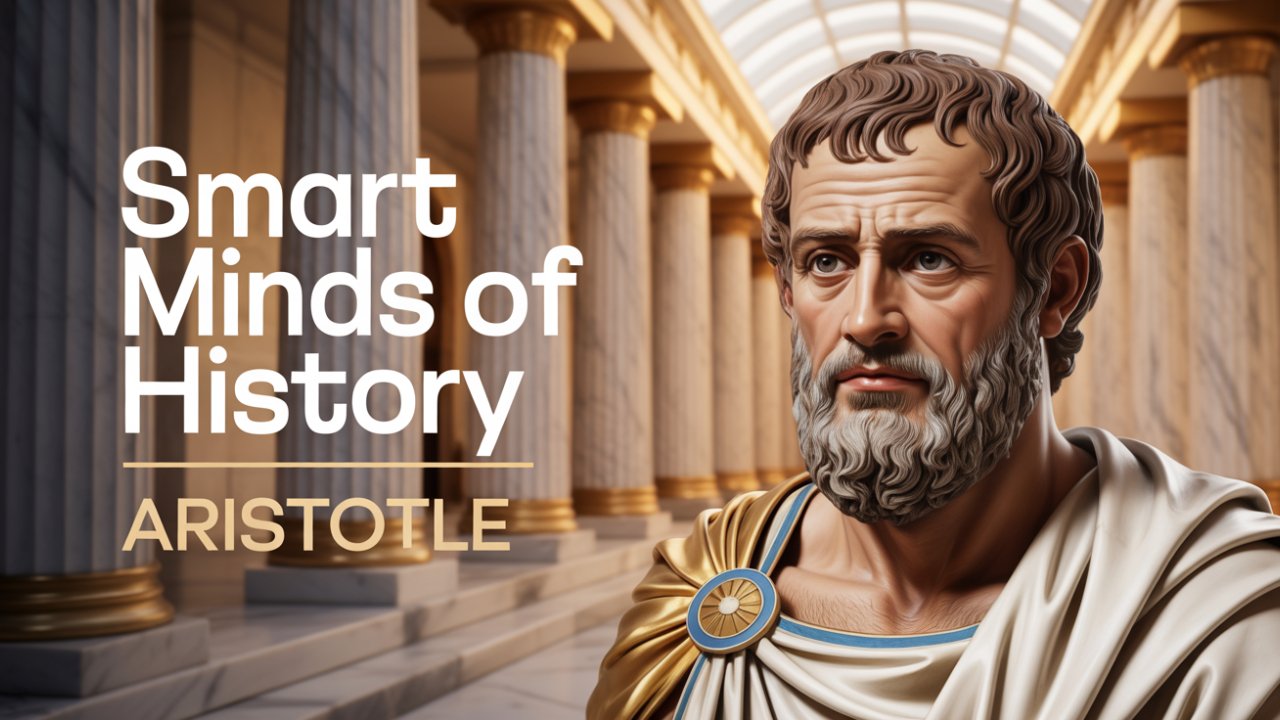In the vast library of human thought, a few names echo with a special power. But one figure stands so tall that for centuries, he was known simply as ‘The Philosopher.’ His mind seemed to catalog the entire world, from the smallest sea creature to the largest questions of existence.
His writings became a blueprint for knowledge, shaping the intellectual currents of the West. He was the teacher of the ancient world’s most formidable conqueror, a man who built an empire that stretched across the known world. Yet, the empire of the mind Aristotle constructed has outlasted every kingdom and dynasty. He gave humanity its first real toolkit for reason, a system for thinking that has resounded through the halls of science, religion, and law ever since.
But who was the man behind this monumental legacy? How did one person, born in a small coastal town, manage to build an intellectual framework that would guide and challenge humanity for millennia? This isn’t just the story of a great thinker. This is the story of how we learned to think. This is the story of Aristotle.
To understand the architect of Western thought, we have to travel back to 384 BCE, to the town of Stagira on the northern coast of Greece. This wasn’t Athens, the bustling center of culture. Stagira was a provincial town, but it had a crucial link to power. Aristotle’s father, Nicomachus, was the personal physician to King Amyntas III of Macedon, a rising kingdom to the north.
This connection was key. First, it put the young Aristotle in the orbit of royalty from his earliest days. Second, it grounded him in a family tradition of medicine. While his future teacher, Plato, would look to the abstract world of mathematics for inspiration, Aristotle’s mind was shaped by the tangible, observable world of biology and anatomy. His father’s profession valued empirical observation and detailed examination a method that would become the hallmark of Aristotle’s entire philosophy.
But tragedy struck early. When he was just a boy, both of Aristotle’s parents died, leaving him in the care of a guardian. While this loss undoubtedly shaped him, his education continued, covering Greek, poetry, and rhetoric. This blend of scientific observation and literary skill would later allow him to articulate his world-changing ideas with stunning clarity. The Roman statesman Cicero would one day marvel that “If Plato’s prose was silver, Aristotle’s was a flowing river of gold.”
At seventeen, his life took a pivotal turn. He was sent to Athens, the intellectual capital of the world, to enroll in the most prestigious school in existence: Plato’s Academy. For the next twenty years, Aristotle would live, study, and teach within its walls. The Academy wasn’t just a school; it was a vibrant community of thinkers grappling with the biggest questions of reality, knowledge, and ethics. At its head was Plato, the giant of Greek philosophy, who argued that the physical world we see is just a shadow of a higher, perfect realm of Forms.
Aristotle was, by all accounts, Plato’s most brilliant student. He absorbed the teachings, debated fiercely, and earned his master’s respect. And yet, the seeds of dissent were already being sown. While Plato looked to the heavens for truth, Aristotle’s instincts drew him to the earth to the tangible reality all around him. He began to build a philosophy grounded not in an unseen realm, but in the intricate, messy, beautiful world we can all experience. As he famously put it: “Plato is my friend, but truth is a much better friend.”
When Plato died in 347 BCE, leadership of the Academy didn’t pass to Aristotle. Instead, it went to Plato’s nephew. Whether this was a personal slight or due to rising anti-Macedonian sentiment in Athens is unclear. What is clear is that it was the end of a chapter. Aristotle, now 37, left Athens. He traveled to Assos, on the coast of Asia Minor, where he advised the local ruler, married his wife Pythias, and dove headfirst into the study of marine biology. It was here, in the coastal lagoons, that he conducted pioneering research, dissecting and documenting the life teeming in the sea. This wasn’t a detour; it was philosophy in action.
His reputation hadn’t gone unnoticed. Around 343 BCE, he received a summons that would once again change his life. King Philip II of Macedon invited him back to be the royal tutor to his thirteen-year-old son. That son was Alexander, the boy who would become Alexander the Great. For the next few years, Aristotle was tasked with shaping the mind of the future conqueror, teaching him rhetoric, politics, and philosophy. While Alexander would go on to carve out an empire with his sword, Aristotle gave him the intellectual tools to understand the world he would rule.
When Alexander ascended the throne, Aristotle’s work was done. In 335 BCE, now fifty years old, he returned to Athens. But he didn’t go back to Plato’s Academy. Instead, he founded his own school in a public gymnasium outside the city walls known as the Lyceum.
The Lyceum was a revolution. It was more than a school; it was a pioneering research center. At its heart was one of the first great libraries, a vast collection of manuscripts, maps, and natural specimens. Aristotle and his students would often hold discussions while walking along the covered colonnades, or peripatoi, which gave his followers the name “The Peripatetics” the “walkers.”
For twelve years, the Lyceum flourished as Aristotle produced the bulk of his surviving works. But this golden age was tied to the fortunes of his former pupil. In 323 BCE, news came that Alexander the Great had died. With the conqueror gone, anti-Macedonian sentiment in Athens boiled over. A charge of impiety was brought against Aristotle the same charge that had condemned Socrates a century earlier. Unwilling to let Athens “sin twice against philosophy,” Aristotle fled the city for the last time. He died only a year later, in 322 BCE, leaving behind a body of work so vast its full impact was only just beginning to be felt.
This intricate life, moving between philosophy, science, and political power, set the stage for an intellectual explosion. If you’re finding this journey fascinating, make sure to subscribe and hit the notification bell so you don’t miss our next explorations. Now, let’s get into the first, and perhaps most crucial, of his contributions: the invention of logic itself.
Before Aristotle, philosophy was a vibrant but unruly landscape. Thinkers like Socrates and Plato asked profound questions, but the process of argumentation of getting from one idea to the next reliably was largely intuitive. There was no universal rulebook for reason. Aristotle changed that forever. He didn’t just contribute to logic; he essentially invented it as a formal discipline. He created the world’s first systematic method for thinking, a toolkit so powerful it would remain the foundation of Western logic for over two thousand years.
His followers later gathered his works on logic into a single volume they called the Organon, which is Greek for “instrument” or “tool.” The name is perfect. Aristotle saw logic not as a subject in itself, but as the essential tool every other science needed to function correctly. It was the master key that could unlock reasoned conclusions in any field.
It all starts with his Categories, where he examines the very building blocks of language. He identified ten fundamental ways we can describe something: what it is, how much, what it’s like, and so on. This wasn’t just grammar; it was a map of reality, designed to bring clarity to our thoughts.
But the centerpiece of the Organon, and Aristotle’s most famous logical contribution, is the syllogism. A syllogism is a deductive argument where a conclusion is inferred from two premises. Aristotle’s genius was realizing that the validity of an argument depends not on what it’s about, but on its structure.
The classic example says it all: Premise 1: All men are mortal. Premise 2: Socrates is a man. Conclusion: Therefore, Socrates is mortal.
Aristotle showed that as long as the premises are true and the structure is valid, the conclusion must be true. You could swap in corgis, dogs, and Fido the logical engine works just the same. This was a breathtaking breakthrough. For the first time, reasoning could be analyzed objectively. He created a formal system that could test the strength of an argument, separating logical necessity from mere persuasion.
He also made a crucial distinction between two modes of reasoning: deduction and induction. The syllogism is the engine of deduction, moving from general principles to specific conclusions. But Aristotle, ever the empiricist, also valued induction: moving in the opposite direction, from specific observations to a general rule. He knew that if you see a thousand swans and every single one is white, you can inductively conclude that “all swans are white.” But he also knew this conclusion was only probable, not certain a key insight for the future of science.
In his Posterior Analytics, he applied this toolkit to science itself, arguing that true knowledge means knowing why something is true, not just that it’s true. He envisioned science as a rigorous, logical structure built on a foundation of first principles.
The creation of the Organon was a turning point in intellectual history. It gave humanity a shared language for reason. It shaped philosophy in the Middle Ages, informed Roman law, and laid the conceptual groundwork for modern science and even computer programming. While logic has evolved since, Aristotle’s core insights remain as fundamental today as they were in the walking halls of the Lyceum. He didn’t just teach us what to think; he taught us how to think.
Having forged the tools of reason, Aristotle turned them toward one of the most fundamental questions of all: How should we live? For Aristotle, this wasn’t an abstract puzzle. It was the most practical question there is. His answer, laid out in his masterpiece, the Nicomachean Ethics, is one of the most influential systems of moral philosophy ever created.
At the heart of his ethics is a single concept: Eudaimonia. This Greek word is often translated as “happiness,” but that’s a bit misleading. For us, happiness is often a fleeting feeling. For Aristotle, Eudaimonia was far deeper. It’s better translated as “human flourishing” or “living well.” It’s not a temporary state, but the ultimate goal, or telos, of a complete human life being the best version of yourself that you can be.
So, how do you get there? Aristotle’s answer is characteristically down-to-earth. You don’t get Eudaimonia from the gods or from pure luck. You achieve it through activity specifically, activity in accordance with virtue. The key to a good life is building a virtuous character.
Here, virtue, or Arete, simply means “excellence.” The excellence of a knife is its sharpness. The excellence of a horse is its speed. The excellence of a human, Aristotle argued, is our unique capacity for reason. A virtuous life, therefore, is a life guided by reason.
He divides virtues into two types: intellectual virtues, learned through teaching, and moral virtues like courage and temperance which are acquired through habit. This is a revolutionary idea. We don’t become good by simply reading about it; we become good by doing good things, over and over, until it becomes second nature.
This is where Aristotle introduces his most famous ethical tool: the Doctrine of the Mean, or the “Golden Mean.” He argued that every moral virtue is a midpoint between two extremes: one of excess and one of deficiency. Take courage. It’s the golden mean between the deficiency of cowardice and the excess of recklessness. The courageous person isn’t fearless that would be foolish. The courageous person feels the right amount of fear but acts correctly despite it.
This model applies across the board:
Generosity is the mean between stinginess and wastefulness.
Temperance is the mean between self-indulgence and being completely insensible to pleasure.
Even a good sense of humor is a mean between buffoonery and boorishness.
The Golden Mean isn’t a call for mediocrity, and it’s not a simple mathematical average. Finding the mean is relative to us and the situation. It requires what Aristotle called Phronesis, or practical wisdom a kind of moral street-smarts, honed by experience, that allows us to see what the right action is in any given moment.
This is a deeply humanistic and empowering vision of morality. The goal isn’t to blindly obey a set of rules, but to become a certain kind of person someone whose character has been so well-shaped by practice and reason that they reliably choose the right action, for the right reason. That person, Aristotle argues, is the one who will achieve true flourishing.
Aristotle’s ambition was encyclopedic: to understand and explain the entire world. He was, in essence, the ancient world’s first great scientist, who saw the path to knowledge not just through pure reason, but through rigorous, hands-on observation.
His most lasting scientific contributions were in biology. During his time on the coasts of Asia Minor, Aristotle performed meticulous studies of animal life, dissecting and observing hundreds of species. His writings are filled with detailed anatomy and notes on animal behavior. For instance, he was the first to describe the complex stomach of ruminants. In a remarkable insight, he also observed that dolphins and whales are not fish; he noted they breathe air, give live birth to their young, and produce milk, characteristics we now associate with mammals.
But he didn’t just collect facts; he organized them. He created the first systematic classification of the animal kingdom, a project of stunning ambition he called the Scala Naturae, or “Ladder of Nature.” This ladder progressed from inanimate matter up through plants, then various levels of animals, and finally to human beings at the very top. While this system wasn’t evolutionary, his method of grouping organisms by shared, observable traits laid the groundwork for the science of taxonomy developed thousands of years later.
To explain things, he proposed his famous Four Causes:
The Material Cause: What is it made of? (The bronze of a statue)
The Formal Cause: What is its form or design? (The sculptor’s idea)
The Efficient Cause: What brought it into being? (The sculptor)
The Final Cause (or Telos): What is its purpose? (To be an object of beauty)
This framework, especially the emphasis on purpose, guided all his research. The wing of a bird, for instance, could only be fully understood by recognizing its purpose: flight.
He extended this desire for explanation to the entire cosmos. His physics presented a grand, unified picture of the universe which, while ultimately proven wrong, would dominate Western science for nearly 2,000 years. He envisioned a cosmos of four elements earth, water, air, and fire each with its natural place. A rock falls because its nature is to return to the earth; fire rises because its nature is to ascend.
Above this earthly realm were the heavens. The sun, moon, and stars were made of a fifth, perfect element called aether, and they moved in perfect circles around a stationary Earth. This geocentric model was an elegant synthesis of observation and philosophy, and it became scientific dogma until Copernicus and Galileo.
Finally, his inquiries pushed beyond the physical world into what he called “first philosophy,” or as we know it today, metaphysics. Here, Aristotle grappled with the most fundamental questions of existence. He argued that everything in the world is a combination of matter (its potential) and form (its actuality). An acorn has the potential to become an oak tree; the tree is the actuality of that potential. But what started all this change and motion? To avoid an infinite chain of cause and effect, he reasoned there must be a first cause, something that causes motion without itself being moved. He called this the Unmoved Mover pure, perfect, unchanging thought. It doesn’t physically push the universe; it moves it by being an object of aspiration, much as a goal can inspire us to act. This concept would later be profoundly influential for Jewish, Christian, and Islamic theologians.
Though much of his specific science has been superseded, Aristotle’s legacy as a scientist is secure. His insistence on empirical observation and his ambition to create a comprehensive explanation for all of reality established the very spirit of scientific inquiry.
The death of Aristotle was only the beginning of his story. His writings, initially preserved at the Lyceum, faced a precarious future, eventually finding their way to Rome. While he was influential in the Roman world, his true intellectual reign began centuries later.
As Europe entered the Middle Ages, much of Aristotle’s work was lost to the Latin-speaking West. But it was preserved and treasured in the Byzantine and Islamic worlds. Arabic scholars in Baghdad and Córdoba were captivated, giving him the title, “The First Teacher.” Thinkers like Avicenna and Averroes translated his works and integrated his ideas into a flourishing intellectual tradition.
It was largely through these Arabic translations that Aristotle was reintroduced to Western Europe in the 12th and 13th centuries. The arrival of this vast body of knowledge was an intellectual shockwave. At first, the Church was suspicious. But then came thinkers like Thomas Aquinas, who undertook the monumental task of synthesizing Aristotelian philosophy with Christian theology. He used Aristotle’s concepts and logic to build a rational foundation for Christian doctrine. Through Aquinas, Aristotle became The Philosopher, his system forming the bedrock of medieval thought.
This dominance lasted for centuries, but the Scientific Revolution of the 16th and 17th centuries took direct aim at his science. Copernicus displaced the Earth from the center of the universe. Galileo’s telescope revealed imperfections in the heavens. One by one, the pillars of Aristotle’s physics were dismantled by a new generation of scientists.
And yet, to see this as the “end” of Aristotle is to miss the point. The scientific revolution was made possible by the very principles he had championed: empirical evidence, logical reasoning, and the division of knowledge into disciplines. He had laid the groundwork for his own succession.
Today, his influence continues. His political theories still inform political science. And remarkably, the last century has seen a powerful resurgence of his moral philosophy. “Virtue ethics,” inspired directly by Aristotle, has become a vital branch of contemporary thought, focusing once again on character, flourishing, and the lifelong project of building a good life.
From the shores of ancient Greece to the lecture halls of the 21st century, the journey of Aristotle’s thought is a testament to the power of a single mind. He was a polymath of unparalleled breadth who sought to bring the entire universe within the grasp of human reason.
He wasn’t infallible. His physics was flawed and his social views were bound by his time. But to focus on where he was wrong is to overlook his monumental achievement. He showed us that the world was not just a realm of myth and mystery, but an intelligible system that could be understood through observation, classification, and clear thinking.
He remains “The Philosopher” not because he had all the answers, but because he taught us how to ask the questions. His legacy isn’t a set of dusty dogmas, but an ongoing invitation an invitation to observe carefully, think logically, live deliberately, and never stop trying to understand our world and our place in it. The genius of Aristotle isn’t just a chapter in history; it’s woven into the very fabric of how we think today.





